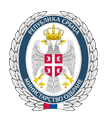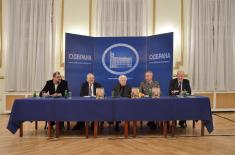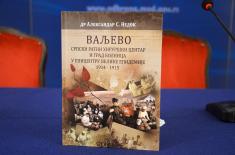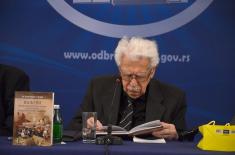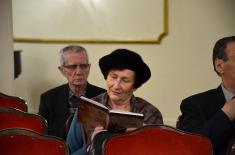28.11.2017.
Promotion of the book on the Valjevo hospital
In the ceremonial hall of the Central Military Club today, in cooperation with the Valjevo National Museum and the Medical History Section of the Serbian Medical Society, promotion of the Scientific Advisor Primarius Doctor of Medical Sciences Aleksandar S. Nedok - “Valjevo - Serbian War Surgical Center and city-hospital in the epicenter of the great epidemic from 1914 to 1915”, published by the National Museum of Valjevo, was held.
The work was created as a result of Dr. Nedok's multi-decade study of Serbian military medical service and is a synthesis of his previous works, published and unpublished, with the addition of some so far unknown details.
The keynote speakers at the promotion were reviewers – retired General Dr. Veljko Todorović and Colonel Prof. Dragan Mikić, Head of the Clinic for Infectious and Tropical Diseases of the Military Medical Academy and Medical General Officer Dr. Branislav Popović, who have been the author's associates and coauthors of works for more than ten years. On behalf of the publisher, Dr. Vladimir Krivošejev, Director of the National Museum of Valjevo, editor of this book, and finally the author, addressed the audience.
General Dr. Todorović, speaking about the contents of the book, said that 123 pages, divided into three parts, describe the period in which Valjevo and its hospitals became a symbol of the suffering in the Great War, but also a symbol of dedication, humanity and international cooperation in the fight against the epidemic of unprecedented proportions. The first part of the book, which is titled “Valjevo - the city hospital”, shows the situation in Valjevo from the beginning of the war until the end of the Battle of Kolubara. The second part describes the epidemic of three typhoids, and the third one lists the medical personnel who lost their lives in the war events from 15th July (according to the old calendar) 1914 to 30th September 1915.
According to Dr. Todorović, the richness of the book is in original documents, topographic maps with military tactical positions, 24 tables and graphs, 67 photographs, some of which were published for the first time because they are from Dr. Nedok's personal archives and citations (147 bibliographic data) most of which are original documents, war reports of the units and the Supreme Command of the Serbian army, hospital protocols, professional papers of the doctors war participants, which Dr. Nedok collected and studied for years.
- In this book, through the work of medical service during one year, the epic of the ancient proportions of the Serbian people and his army, an epic ranging from the fall, defeat and the risk of total failure to the magnificent victory and liberation of the South Slav peoples, was shown. It shows a part of the difficult and unequal struggle of a small and weak but proud people for their freedom and survival, General Dr. Todorović said and stressed that this was the most difficult and challenging period "when with maximum efforts, although with limited human and material resources, life defeated death and won a definitive victory."
Military infectologist, Colonel Prof. Mikić recalled that "little Serbia faced with the Great War completely unprepared in the medical sense" and that epidemics of dysentery, abdominal, reversible and especially "historical" typhus, and fewer other infectious diseases, spread like fire in the Serbian army and the people at the end of 1914. He said that those disaeasters had caused such losses to Serbia as no other people and no other army had in the First World War. He pointed out that, based on the assessment of Dr. William Hunter, Head of the British medical mission, who arrived in Serbia in March 1915, the typhus epidemic in Serbia in 1914/1915 was "the most surprising epidemic in origin, the fastest in the flow, the highest in intensity, and the fastest stopped compared to all known such epidemics in history." The worst situation was in Valjevo hospitals.
Colonel Prof. Mikić cited excerpts from the medical notes from that time about the situation in Valjevo at that time.
“There were horrifying scenes of mass suffering and death in hospitals of both patients and hospital staff ... People could not manage to bury the dead. Near the hospital there was a pile of corpses. There were cases where, by mistake, the unconscious ones were also put on the piles of the corpses.” Or: “Due to the overcrowding of hospitals, due to scarcity in resources and failure to separate those infected from other patients and wounded in them, everyone got infected and died in them even if they were not infected when they came... Cry, call for help, sighing, the last jabber - were coming from the distance to the ears! The situation in the hospitals was not only unsatisfactory, but terrible ... the sick, even the hardest affected ones, those who were rumbling, bedridden ones and those who fight with their soul, all of them mixed on assembled beds, under the beds, on the floor, and even in the corridors ... The food is given to the sick randomly and by the eye, and it is taken to the ward by prisoners, who drink it, eat it and even sell it along the way.”
Professor Dr Mikić said that we today, looking at that time, cannot understand those horrors that happened to us, which many wrote about, and even them, and thus Dr. Nedok, so he pointed out:
- We did not write them in order to write something, but to teach you that it should not be forgotten that the epidemics broke out due to someone's inability, disorganization, neglect, ignorance, and ultimately because of the lack of medicaments, because such mistakes are always possible.
Speaking about the importance of Dr. Nedok's work, retired Major General Dr. Branislav Popović reminded those present of the beginnings of work and research on the history of the Serbian military medical service. He said that Dr. Nedok joined a group of doctors and soldiers, more than 20 of them, who spent almost a decade researching and presenting their results at five symposiums and published a dozen of books.
- This is the last book by Dr. Nedok, General Popović said a bit as a joke, but it is not known by when, because for every one he says that it is the last one. - Doctor Nedok has the will and the desire to write a lot more thus making us to follow his way.
Prof. Vladimir Krivošev spoke about the situation in which he met Dr. Nedok, but also about the significance of his work. He pointed out that Dr Nedok worked on the book, he helped to periodise the work of the Valjevo Hospital and that Valjevo – the city hospital was regarded as a historical process, which has two completely different periods and its sub-periods.
All participants in the promotion spoke with carefully selected words about Dr. Nedok, a scientific adviser, doctor of medical sciences, primarius, cardiologist, long-time member of the Academy of Medical Sciences of the Serbian Medical Society, a top knowledgeable historian of the Serbian military service, honorary Major of the Serbian Armed Forces. They emphasized his versatility, creativity, dedication and authenticity, saying that he was a man of brilliant thoughts, an inexhaustible working spirit and a patriotic enthusiasm who continues to write even though he is in his tenth decade of life.
The tradition is binding him on this, as the author said at the end of the promotion, because every generation of the Nedoks had doctors, and this last book has a personal stamp.
- This book, together with my book "Retreat of 1915, is the most emotionally experienced and written. And this is why this work in particular fulfills my multiple wish: to give my childhood city a part of my gratitude for those beautiful days of childish carelessness and happiness that it has given to me, to bow down deeply to the shadows of those who courageously entered the epidemic and burned out in it and to pay homage to its many unnamed inhabitants for their nobility that they showed to the wounded and sick heroes, Dr. Nedok said, pointing out that it is a book of pride and sorrow.
The names of the injured doctors in the war events from 15th July 1914 to 30th September 1915 are known and they are given at the end of the book as a never-to-forget list. Even before it was published, the manuscript of this book was awarded in 2016 the second prize for the historiography by the Dragojlo Dudić Foundation, and was promoted for the first time at the beginning of the year at the Military Medical Academy.
 PHOTOGALLERY
PHOTOGALLERY